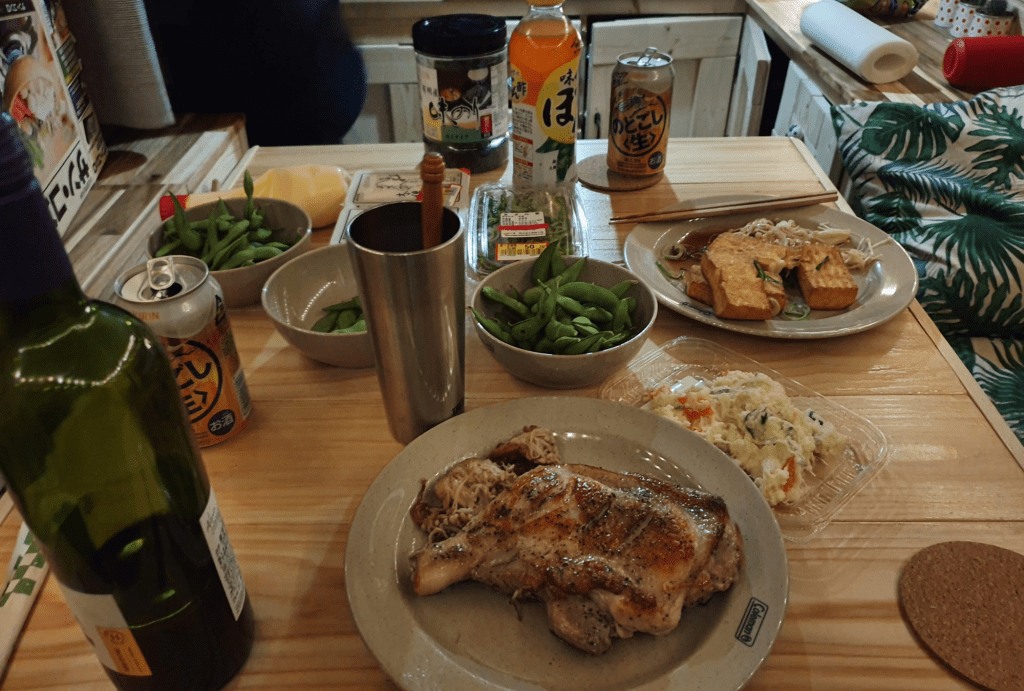8 Easy Money Saving Tips For Travelling Japan By Camper Van
You are here:
- Home
- Van Life Japan
- 8 Easy Money Saving Tips…
Van Life in Japan is an incredible way to travel and discover places off the beaten track, however if you are not careful, the costs can easily add up since it’s easy for everyday to end up feeling like a holiday!
We previously wrote a blog post sharing how much our monthly expenses are for living in a van in Japan. Click here to see the blog post!

We have been living in our van in Japan for almost one year now and as time goes on, we discover more and more hacks and ways to make our money go further. It’s definitely possible to travel Japan on the cheap and in this blog post we will share our top money saving tips!
These tips might also be useful for anyone who is living in Japan and anyone who plans to travel in Japan!

The prices of fresh produce in Japan are very much based upon seasonality. For example, cucumbers and tomatoes are always cheapest during the summer!
In Japan, if you want to buy fresh produce when it is out of season, you can expect the prices to be considerably higher. This is quite different to other countries where the prices don’t vary too much from season to season.

The best tip to save money is to go shopping and buy whatever fruit or vegetables are cheap then search for a recipe rather than choosing the recipe first!
Ruth has been using two food blogs called “just one cookbook” and “chopstick chronicles” to learn Japanese recipes. The blogs are written by Japanese ladies living overseas and are full of delicious recipes!

Paid campsites are great since they usually provide clean facilities but if you stay in campsites every night, the costs can really add up over the course of a month. Luckily in Japan, there are many government owned free campsites available for van lifers and campers to use.
It’s also possible to stay overnight in other free locations such as roadside stations, parks or random locations. We try to stay overnight for free as much as possible to help reduce costs.
Check out our blog post about staying overnight at Japanese roadside stations.

In Japan, there are some incredible highways and bridges that are amazing pieces of engineering, however if you want to use these routes, there is usually a toll involved.
The tolls can be quite expensive and can add up, especially if you are driving a lot! We always try to avoid toll roads since there is always a free alternative route.
The free route usually has many traffic lights and takes much longer so if you don’t have much time it might not be the best option. One positive about taking the free route is that the views are always much better!

Supermarkets in Japan usually start to discount pre-packaged food a few hours before closing time. The discounts usually start at 20% and then increase to 50% the closer it gets to closing time.
We usually check what time the supermarket closes and aim to visit 2-3 hours before closing. It’s possible to get some delicious food for half price and it’s a great way to save money!

If you get chatting to some locals or other van lifers parked in the same overnight spot you can ask them if they know of any cheap shops, restaurants or nearby places to take a shower.
Sometimes there are some really affordable places but they don’t appear on google maps. We have discovered some really cheap places to take a shower and cheap vegetable shops just by speaking to people!

We always use the application gogo.gs to check the nearby gasoline prices before we fill up our tank. The prices in the same town can vary by up to ¥15 per litre!
This means that if you have a 65 litre fuel tank, it could result in a saving of ¥975 per refuel. It might not seem a lot but if you fill your tank once per week, this comes to a total of ¥975 x 52 weeks = ¥50,700!

We always use coin laundries to wash our clothes while travelling by van in Japan and the minimum cost of visiting a coin laundry is usually around ¥1000 (¥700 for washing and ¥300 for drying).
We used to visit a coin laundry once per week since we only had 7 sets of underwear each. Underwear was always the first thing we ran out of so we decided to buy enough underwear to last for 14 days.
This means we now need to only visit the coin laundry around once every 2 weeks. We need to use a bigger washing machine and dryer since there is more kilograms of laundry to do but each visit to the coin laundry now costs around ¥1400 (¥1000 for washing and ¥400 for drying).
The investment of buying more sets of underwear has saved us money on visiting a coin laundry so often!

There are many amazing onsens all over Japan and it’s one of the highlights of travelling to new places. However, if you visit an onsen everyday, the costs will definitely add up! A visit to an onsen usually costs around ¥600 or more, depending on its location and water quality.
Sentos are cheaper alternatives which are public bath houses that heat water electronically rather than use water from a natural hot spring. It usually costs around ¥400 to visit a sento, so over time you can make some savings.
Coin showers can sometimes be found in big towns, campsites or at roadside stations and usually cost ¥100 for 5-8 minutes. If showers are available, they are a cheap option and are recommended if you are looking to save money.

Japan is known overseas as being a really expensive country to travel in but we disagree! It CAN be a very expensive country to travel in if you take the bullet train, stay in ryokans, eat out for breakfast, lunch and dinner and buy loads of souvenirs!
We are cautious about how we spend our money since we are travelling long term and Japan can definitely be travelled on a low budget.
It has taken us some time to realise these cost saving tips so we hope that by sharing what we have learnt, you can also benefit and make your money go further when travelling in Japan!